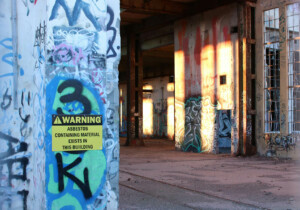Fast Company recently reported on the potential comeback of one of the most infamous building materials of recent memory. Asbestos is now legally allowed back into U.S. manufacturing under a series of loopholes by the Environmental Protection Agency (EPA). As Fast Company reported, on June 1, the EPA authorized a “SNUR” (Significant New Use Rule) that allowed the distribution of products containing asbestos on a case-by-case basis.
According to Fast Company, the EPA’s recently released report detailing its new framework for evaluating the risk of its top prioritized substances states that the agency will “no longer consider the effect or presence of substances in the air, ground, or water in its risk assessments.”
This news comes after the EPA reviewed its first batch of 10 chemicals under the 2016 amendment to the 1976 Toxic Substances Control Act (TSCA), which requires the agency to continually reevaluate hundreds of potentially toxic chemicals in lieu of removing them from the market or placing new restrictions on their use. The SNUR greenlights companies to use toxic chemicals like asbestos without consideration about how they will endanger people who are indirectly in contact with them.
Asbestos was widely used in building insulation up until it was completely banned in most countries in the 1970s. The U.S. severely restricted its use without completely outlawing it. As Fast Company covered, the Asbestos Disease Awareness Organization (ADAO) revealed in April that asbestos-related deaths now total nearly 40,000 annually, with lung cancer and mesothelioma being the most common illnesses in association with the toxin.

Healthy Building Network (HBN), an environmental advocacy group, told Fast Company that the fibrous material poses a major health risk for everyone exposed to it, including those who mine it, those who handle it in industrial facilities, as well as people near or inside renovation and construction projects where it’s being used. HBN’s Board President Bill Walsh said that the chlor-alkali industry is the only industry in the country that still uses asbestos, reportedly importing about 480 tons of the carcinogen each year from Russia and Brazil.
Walsh pointed out to Fast Company that chlorine-based plastics are commonly found in building-product materials and that “virtually all” asbestos in the U.S. is used in the industrial process to make chlorine. This includes PVC and vinyl plastics, which is largely found in the creation of pipes, tiles, flooring, adhesives, paints, and roofing products.
Though the EPA is now easing its regulations against integrating the harmful toxin and others like it under the Trump administration, it will largely be the responsibility of local and state governments, as well as companies and informed consumers to counter these new federal moves. Walsh told Fast Company it’s up to sustainable building-product manufacturers and ultimately, architects to pressure the market.
“Architects really set the pace of design, in terms of aesthetics and materials that we like,” he told Fast Company. “If they start to incorporate health-based criteria into their palette, it could really have an influence on what the manufacturers produce.”

Earlier last month, The Washington Post noted that the Environmental Working Group (EWG) and the ADAO had discovered a controversial post on Russian asbestos exporter Uralasbest’s Facebook page showing photos of company pallets stamped with a seal of U.S. President Donald Trump’s face. As The Post covered, Trump has long been vocal about his skepticism about the harmful effects of asbestos, claiming in his 1997 book, The Art of the Comeback, that anti-asbestos efforts were “led by the mob.” The Post uncovered how in 2012, he tweeted that the World Trade Center might not have burned had the fire-retardant material not been removed from the towers. It’s estimated that 400 tons of asbestos fiber went into the structures before the developers stopped it from being used further in 1971.
The EPA told The Washington Post it will conduct further studies on the first 10 chemicals under the amended TSCA and final risk evaluations will published in December 2019.











